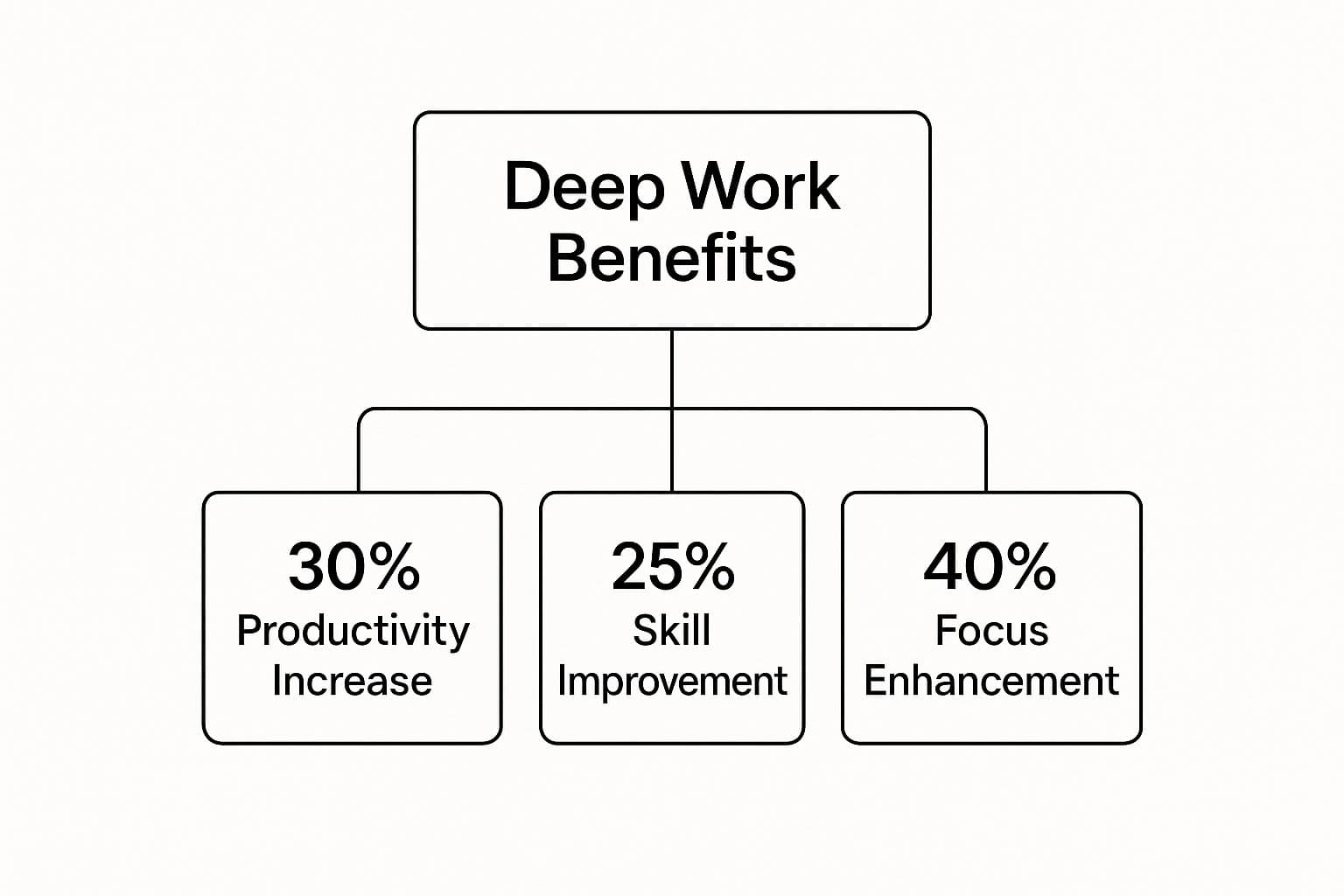Discover key insights in this deep work summary. Learn proven strategies to improve focus and get more done efficiently.
Do less, be more with Fluidwave
Fluidwave combines smart task prioritization with an assistant marketplace — AI and human help, all in one productivity app.
August 22, 2025 (3mo ago)
Deep Work Summary: Master Focus & Boost Productivity
Discover key insights in this deep work summary. Learn proven strategies to improve focus and get more done efficiently.
← Back to blog
In a nutshell, deep work** is a powerful strategy for hitting peak productivity. Author Cal Newport defines it as any professional activity you perform in a state of distraction-free concentration, pushing your cognitive abilities to their absolute limit. This is the kind of effort that creates new value, sharpens your skills, and is incredibly difficult for others to replicate.
What Is Deep Work and Why It Is Your Competitive Edge

Picture a master craftsman, completely absorbed in their work, shaping a piece of wood into something beautiful. That's the essence of deep work—it’s the ability to tackle difficult challenges and produce results at an elite level. In our constantly connected world, this skill isn't just a nice-to-have; it's a modern-day superpower that separates the top performers from everyone else.
On the other side of the coin, you have shallow work. These are the tasks that don't demand much brainpower, often logistical things we do while distracted. Think about your average workday:
- Answering emails the second they land in your inbox
- Sitting through endless status update meetings
- Fielding instant messages and pings all day
- Making minor administrative tweaks
These tasks have to get done, but they don't create much new value. The real danger is that they can easily gobble up your entire day if you're not careful. The problem is that many workplaces reward this visible "busyness" over the quiet, focused effort that actually leads to breakthroughs.
The True Value of Deep Focus
The ability to concentrate deeply is becoming rarer at the very same moment it's becoming more valuable in our economy. This gap creates a massive opportunity for anyone willing to cultivate it. To really understand this advantage, it helps to explore other timeless methods for improving productivity that go hand-in-hand with a focused mind.
Newport's central idea is straightforward: The Deep Work Hypothesis: The ability to perform deep work is becoming increasingly rare at exactly the same time it is becoming increasingly valuable in our economy. As a consequence, the few who cultivate this skill, and then make it the core of their working life, will thrive.
Understanding this difference is the first step toward taking back your time and attention. By learning https://fluidwave.com/blog/how-to-focus-better-at-work, you can produce higher-quality work and get more done in less time. This summary will break down the essential rules for making this skill a cornerstone of your professional life.
Rule #1: Adopt a Deep Work Ritual
You can't just stumble into a state of deep work. It’s a discipline, and like any discipline, it thrives on routine. Think of an athlete’s pre-game ritual—it’s not just superstition; it’s a mental trigger that says, "It's time to perform." You need the same kind of trigger for your brain.
Creating a ritual takes the guesswork out of focus. Instead of wasting precious mental energy deciding when, where, and how you'll work deeply, you build a system that runs on autopilot. This frees up your willpower for the only thing that matters: the task at hand.
Finding Your Deep Work Philosophy
Cal Newport gets that a one-size-fits-all approach doesn't work for scheduling focus. Our careers and lives are too different. He lays out four distinct philosophies, and the trick is to find the one that actually clicks with your own professional rhythm.
Which Deep Work Philosophy Fits You Best?
Choosing the right scheduling philosophy is the first step toward making deep work a sustainable habit. This table breaks down Newport's four approaches to help you see which one aligns best with your work life.
| Philosophy | Core Principle | Best For | Example Scenario |
|---|---|---|---|
| Monastic | Drastically minimize or eliminate all shallow work. | Academics, authors, or anyone whose work is defined by singular, profound output. | A novelist who retreats to a cabin for months to write, cutting off most outside communication. |
| Bimodal | Divide your time into clearly defined deep and shallow periods. | Consultants or professors who have distinct project-based work and client-facing periods. | A professor who spends the academic year teaching and then dedicates the entire summer to research. |
| Rhythmic | Turn deep work into a consistent, daily habit. | Most professionals who need to balance focused work with ongoing collaborative tasks. | A programmer who sets aside 90 minutes every morning, without fail, to code before checking email. |
| Journalistic | Fit deep work into any free moment in your schedule. | Experts with highly trained focus who can switch gears on a dime. | A CEO who uses an unexpected 30-minute gap between meetings to draft a critical strategy memo. |
The Rhythmic philosophy is often the most accessible starting point for people in typical office jobs. It builds a powerful chain of consistency. You could even integrate effective timeboxing techniques to put a hard, protective barrier around those daily sessions.
The Journalistic approach, on the other hand, is the black belt of deep work. It’s incredibly difficult because it requires an almost immediate shift from a shallow to a deep mindset, something that takes a long time to train.

As you can see, the benefits aren't just marginal. Committing to a consistent practice creates a powerful feedback loop, improving not just your output but your ability to focus and learn new skills faster. It’s one of the most impactful habits you can build in your professional life.
Rule 2: Learn to Embrace Boredom

To really master deep work, you have to win the battle against distraction. The battlefield? Your own brain. In a world practically overflowing with pings, posts, and notifications, our minds have been trained to constantly hunt for the next quick hit of new information.
This constant switching from one thing to another shreds our ability to concentrate. Cal Newport’s advice is a bit counterintuitive: don’t just try to focus when you sit down to work. Instead, you have to train for it all the time. The secret is to embrace boredom.
Think of your concentration like a muscle. Every time you reflexively pull out your phone while waiting for your coffee or standing in an elevator, you’re training that muscle to expect stimulation. You’re telling your brain it never has to tolerate a single moment of quiet, which makes it weaker and completely unprepared for the heavy lifting required for true deep work.
Training Your Attention Span
Strengthening your focus isn’t about staring at a wall for hours. It’s about deliberately resisting that twitch for a quick digital fix. By doing this, you're building the mental endurance that deep work absolutely requires.
Newport offers a few practical ways to do this.
-
Productive Meditation: This is a powerful one. Use time that would otherwise be idle—your commute, a walk, or even your shower—to focus intently on a single, specific professional problem. The idea isn't to daydream, but to actively structure your thoughts on that one challenge. You’re training your brain to hold a complex idea without getting sidetracked.
-
Schedule Your Internet Use: This is a game-changer. Instead of having the internet on as a default background hum, set specific, scheduled blocks of time when you’re allowed to go online. Outside of those blocks, it’s off-limits. This small shift turns the internet from a constant distraction back into an intentional tool. It's one of the most effective time management techniques for work you can adopt.
"If you want to win the war for your attention, you can't just sketch out a brilliant master plan. You also need to prepare your mind to endure the slog of the real battles to come." - Cal Newport, Deep Work
By building up your tolerance for boredom, you're doing more than just avoiding distractions. You're forging the mental resilience you need to dive deep into your work and, more importantly, stay there.
Rule 3: Quit Social Media Intelligently
Think of it this way: a master woodworker doesn’t keep a dull, rusty saw in their workshop just because it's popular or because everyone else has one. Every single tool has to earn its place. It must provide a clear, significant, and direct benefit to the quality of their work.
Adopting the Craftsman Approach
This is the heart of what Newport calls the craftsman approach to tool selection. We’re so often trained to ask, "What am I missing out on by not using this app?" The craftsman approach flips the script. It forces you to ask, "Does this tool offer a substantial, positive impact on my most important goals?"
If the answer is a fuzzy "maybe" or centers on minor conveniences, that tool is probably costing you more in fractured attention than it's giving you in actual value. Many of us worry we'll miss out on professional opportunities or fall out of touch with friends if we disconnect. Newport argues that the high-value activities—like producing exceptional work or building real relationships—deliver far more than the scattered, low-value connections most social platforms are designed for.
The craftsman approach to tool selection is a simple filter: Identify the core factors that determine success and happiness in your professional and personal life. Adopt a tool only if its positive impacts on these factors substantially outweigh its negative impacts.
The 30-Day Digital Declutter
So, how do you actually put this into practice? Newport suggests a 30-day digital declutter. This isn't about punishment; it's an experiment to rediscover what truly matters. For one month, you take a break from all the digital noise that isn't absolutely essential.
- Step 1: For 30 days, step away from any optional technologies. This means social media, news feeds, or any app you use out of habit rather than necessity. Be disciplined here.
- Step 2: During this break, rediscover what high-quality leisure feels like. Read a book, pick up a hobby you’ve ignored, or have a focused, in-person conversation.
- Step 3: After the 30 days are up, reintroduce technologies slowly and intentionally. For each one, apply the craftsman filter. Only let a tool back into your life if it serves a vital purpose you genuinely missed during your break.
This process helps you shift from being a passive consumer of algorithmic content to becoming a conscious creator of value. It puts you back in the driver's seat, ensuring your digital life serves your ambitions—not the other way around.
Rule 4: Systematically Drain the Shallows

We've all been there. A day flies by in a flurry of emails, quick chats, and impromptu meetings, yet at the end of it, you feel like you've accomplished nothing of real substance. That’s shallow work, and it’s the silent saboteur of genuine productivity. This final rule from Newport gives us a battle plan to reclaim our days from these low-value tasks.
The principle is simple: be ruthless and intentional with every minute of your workday. If you aren't, shallow work will inevitably expand to fill every unscheduled moment, squeezing out the focused effort that actually moves the needle. This isn't about neglecting your duties; it’s about architecting your schedule to prioritize high-impact results.
Make Your Time Intentional
One of the most effective tactics Newport offers is to schedule every minute of your day. This might sound extreme, but the goal isn't to follow a rigid, unchangeable plan. Instead, it’s about forcing yourself to consciously decide what deserves your attention at any given time. Go ahead and block out everything—deep work sessions, email batches, meetings, and even your breaks.
Suddenly, your calendar is no longer just a list of appointments; it becomes a strategic blueprint for your focus. When an unexpected task pops up, you have to actively rearrange your plan, forcing a deliberate trade-off instead of just letting another distraction pile on. This kind of structured planning is essential for focus, and many work-from-home productivity tips build on this exact principle.
Here's another great mental filter: quantify the depth of every task. Ask yourself, "How long would it take to train a smart, recent college grad to do this?" If the answer is "not long," you're looking at shallow work. This simple question helps you get brutally honest about what activities truly deserve your finite deep work energy.
"Decide in advance what you’re going to do with every minute of your workday. It’s the habit of discerning, in advance, what you’re going to do with your time that matters." - Cal Newport
Become Harder to Reach
Protecting your focus means controlling the communication lines that breed shallow work. You have to make yourself intentionally harder to reach—not to be difficult, but to be more effective when you are available. Set clear expectations with your team about when you'll respond to emails or instant messages.
Technology can also be an ally here, helping to offload some of the mental clutter. It’s no surprise that AI tools are becoming productivity game-changers. In fact, 72% of companies that heavily use AI have reported a boost in output. On an individual level, three-quarters of knowledge workers say AI helps them save time and concentrate better—a perfect recipe for creating more space for deep work.
Putting Deep Work Into Practice Today
It's one thing to read about deep work, but it’s another to weave it into the fabric of your actual workday, especially with remote teams and hybrid schedules. It might seem like a tough ask, but today's flexible work arrangements can actually be a massive advantage. Think about it: remote work naturally strips away a lot of the classic office distractions—the random "got a minute?" shoulder taps, the constant background noise, the impromptu desk-side meetings.
This gives us a golden opportunity to be deliberate about how we structure our environment for focus. But this doesn't happen by accident. It takes a conscious effort, from both individuals and leaders, to guard that precious time for concentration. As more of us work remotely, mastering these principles is the key to sidestepping many of the common remote work challenges that kill productivity.
Structuring Your Remote Workday
For individuals, the first step is drawing clear lines in the sand. Start using the tools you already have, like Slack or Microsoft Teams, to signal when you're head-down in a focus block and truly can't be disturbed. Kill notifications on your phone and computer, and if you can, create a physical workspace that’s separate from the main traffic areas of your home.
For managers, the mission is to build a team culture that prizes deep thinking over the appearance of being constantly available. This isn't just about talk; it requires putting real structures in place.
- Set up ‘focus hours’ for the whole team, creating windows where non-critical meetings and messages are put on hold.
- Encourage asynchronous communication for anything that doesn't need an immediate answer. Not every question needs a real-time conversation.
- Walk the walk. Respect your team's focus blocks and talk openly about why this practice is so important for everyone's success.
The data backs this up. A 2025 productivity report found that people working from home can hit a 22% increase in deep-focus work compared to their office-based counterparts. The numbers are telling: remote workers logged nearly 23 hours of focused time each week, while those in the office only managed 18.6 hours.
In the end, your environment is one of the most powerful tools you have. By taking control and thoughtfully designing it, you and your team can turn deep work from a rare treat into a consistent, everyday advantage.
Your Deep Work Questions, Answered
Alright, so you've got the rules down. But theory is one thing; putting deep work into practice in a messy, real-world job is another. Let's tackle some of the most common questions that pop up when people start trying to carve out that focus time.
How Can I Actually Do Deep Work in a Loud, Open-Plan Office?
The modern open office can feel like the archenemy of deep work, but don't give up hope. It just means you have to be more deliberate about creating your bubble of focus.
Noise-canceling headphones are your first line of defense. They're not just for blocking out sound; they're a universal symbol for "I'm in the zone, please don't interrupt." Also, get aggressive with your calendar. Block out "Focus Time" so your availability is crystal clear to anyone trying to book a meeting.
If your office has them, grab a quiet room or a phone booth for those tasks that require every ounce of your brainpower. And finally, just talk to your team. Let them know what you're doing and why—that you're carving out this time to produce higher-quality work, which benefits everyone.
My Job Demands I'm Always Available. Is Deep Work Even Possible?
Yes, but it requires a mindset shift from being constantly reactive to being intentionally responsive. The goal isn't to disappear; it's to structure your accessibility so you're not constantly being pulled out of a productive state.
This is where scheduling your "shallows" comes in. Instead of checking your inbox every time a notification dings, batch your communication into specific blocks. For example, dedicate 30 minutes at 11:00 AM and again at 4:00 PM to clear out emails and Slack messages.
The crucial step? Tell your team. Let them know your new rhythm so they know when they can expect a reply. This single change can open up massive, uninterrupted windows for real work while still being a reliable teammate.
People often think deep work means being un-contactable. It's not. It's about structuring your availability to protect your focus, which ultimately leads to better work and less burnout.
What's a Realistic Amount of Deep Work to Aim for Each Day?
Don't try to go from zero to eight hours overnight. You'll burn out. When you're first building this mental muscle, aim for a single, focused session of 60 to 90 minutes.
Even Cal Newport, the guy who wrote the book, admits that the world's top thinkers rarely manage more than four hours of true, hardcore deep work a day.
The key here is consistency and quality, not just the number on the clock. Start small. Make sure those sessions are 100% distraction-free. You'll build your focus stamina over time, just like any other kind of training.
Ready to conquer shallow work and reclaim your focus? Fluidwave combines intelligent task management with on-demand virtual assistants to help you prioritize what truly matters. Start streamlining your workflow for free today.
Do less, be more with Fluidwave
Fluidwave combines smart task prioritization with an assistant marketplace — AI and human help, all in one productivity app.